Horseless Carriages - Studebaker Enters the Automotive Age
1900 - 1918
1900 ushered in a world unimaginable just a few years earlier. Marconi, Edison, Bell and others were pioneering new developments that affected the lives of nearly everybody. One innovation just beginning to make an impact was the horseless carriage. Regarded as an expensive novelty by most, there were some people who saw in it the beginning of a new era in transportation. The new body of executives at Studebaker were among the automotive optimists. Leading them was J. M.’s son-in-law Frederick S. Fish who, upon the death of Peter in 1897, assumed the position of chairman of the executive committee. The second generation of Studebakers were also, for the most part, automobile supporters. The elder Studebakers however, were less enthusiastic. Clem vehemently opposed venturing into automobiles while J. M. was lukewarm on the matter. As the Studebakers debated the issue, Fred Fish was tactfully maneuvering the company into a position favorable to entering the horseless carriage market. Clem, as it turned out, would not live to see the day that Studebaker made automobiles. Upon returning from London during the winter of 1901, he collapsed while debarking the ship and died a few weeks later at his home. With Clems passing, opposition to automobiles finally eroded.
In the late 1890s, steam, gasoline and electricity were all being considered as sources of propulsion by automobile designers. Studebaker had experimented with horseless carriages as early as 1896, but was proceeding cautiously. That year, an electrical engineer named George Strong was retained to work on a battery powered carriage. Studebaker opted to go with electricity early on, largely because they were already making electric carriage bodies for taxis under contract for The New York Electric Vehicle Co. This also eased J. M.'s concerns as he regarded steam and gasoline as noisy and dangerous. The testing came to fruition in 1902 when Studebaker introduced it's first production automobile, the Electric Runabout. The first sale occurred five days before the company's 50th anniversary when F. W. Blees of Macon, Missouri purchased the first Studebaker automobile. Thomas Edison is thought to have purchased the second one. The notion that Edison bought the second Studebaker Electric is unsubstantiated. He did however, own a Studebaker Electric and appears to have kept it for 23 years. The Runabout was small and quiet and had a top speed of 13 miles per hour on level ground. Five different models were offered and a total of twenty electric vehicles were sold in 1902. Wagon sales that year topped $4,000,000. J. M. still placed his confidence in wagons.
The notion that Edison bought the second Studebaker Electric is unsubstantiated. He did however, own a Studebaker Electric and appears to have kept it for 23 years. The Runabout was small and quiet and had a top speed of 13 miles per hour on level ground. Five different models were offered and a total of twenty electric vehicles were sold in 1902. Wagon sales that year topped $4,000,000. J. M. still placed his confidence in wagons.
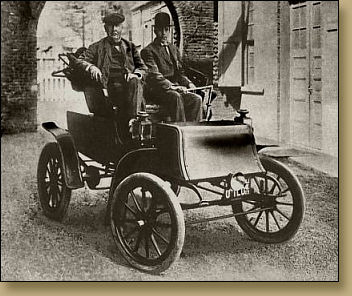
Thomas Edison on a Studebaker Electric.
Even as the electric runabouts were first rolling out of the factory, there was a perception that gasoline power was going to win out in the end. Fredrick Fish was particularly anxious to move in this direction. The main obstacle for Studebaker, he realized, was they lacked the machinery required to manufacture engines and other automotive components. Cleverly, he was able to solve the problem with the stroke of a pen. The Garford Motor Company of Cleveland, founded by Arthur Garford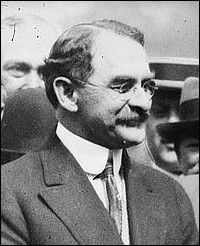
Arthur Garford
1858 - 1933 , had made the chassis for Studebaker's electrics and was now expanding into the manufacture of gasoline engines. Fish worked out an arrangement whereby Garford would supply chassis’ and engines while Studebaker would make bodies and assemble the finished product at South Bend. The cars were to be known as Studebaker-Garfords and the first one was sold as soon as it rolled out of the factory on July 22, 1904. It was purchased by H. D. Johnson, J. M.'s son-in-law, for $2000. The event was attended by newspaper reporters and appears to have been staged for the sake of publicity.
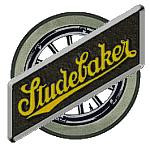
The Studebaker-Garfords were a success and combined sales figures for wagons and automobiles increased dramatically over the next three years until reaching $7,800,000 in 1907. The increase was directly attributable to automobile sales and demand was approaching the breaking point. Garford could not supply components fast enough to keep pace with sales. Immediately after the initial agreement, Garford had constructed a new factory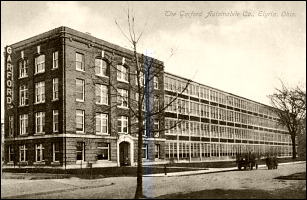
The Garford automobile factory in Elyria, Ohio in Elyria, Ohio with the intention of moving their operations there but construction delays and labor problems were affecting output. In 1908, impatient with Garfords activities, Studebaker gained a controlling interest in Garford through a stock purchase and was able to direct operations to suit their needs. Still unable to meet growing demand, Studebaker acquired the Tincher Motor Car Co of South Bend in 1908 but discontinued these large expensive cars after a year. Something else was needed and again, Fred Fish stepped in with a novel solution.
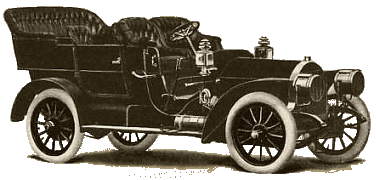
A 1908 Studebaker Garford.
In August of 1908 three gentlemen by the names of Barney Everitt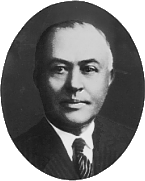
Barney Everitt
1872 - 1940 , William Metzger and Walter Flanders had formed a corporation in Michigan for the purpose of manufacturing automobiles. The Everett-Metzger-Flanders Co was a small conglomerate of seven companies that had been put together by merger and acquision with the intention of building large numbers of medium priced automobiles.
As of October 1, 1909 Everett-Metzger-Flanders Company's subsidiaries consisted of the following:
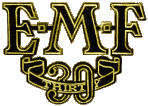
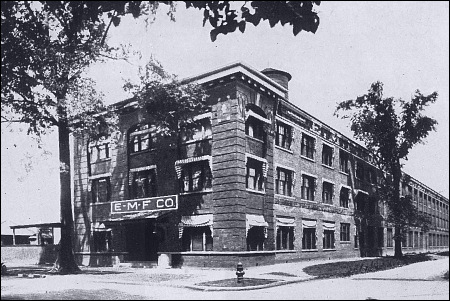
The EMF plant in 1910.
They had not yet begun production and Fish was able to affect an arrangement that was mutually beneficial. EMF at that time had no means of marketing their cars and Studebaker offered to sell them through their vast national sales network contracting for 500 units. They were marketed as medium priced cars in two models, the `20' and `30' (referring to horsepower) at $1,000 and $1,250. The Garford line was continued as a luxury model selling for $4,000. In the 16 months following the EMF deal 8,132 cars were sold. Twelve months later, at the end of 1910, sales had nearly doubled to 15,300.
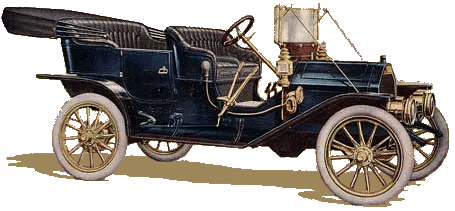
A Studebaker-EMF Model 30.
In the interim though, a behind the scenes battle was being waged between Studebaker and EMF. The model `20' had numerous engineering problems, including faulty transmissions and clutches, which EMF was indifferent to remedy. J. M., who still believed "always give more than you promised", was not at all pleased. More importantly, EMF executives were bickering amongst themselves and then turned on Fred Fish accusing him of manipulating stock prices to affect a buyout. Fish was able to appease the trio by purchasing substantial shares of EMF’s stock but just months later tempers flaired again. This time Fish turned to the courts but EMF stood their ground. The outcome, ironically, was that Studebaker purchased the remaining EMF Fish enlisted the help of J. P. Morgan in the buyout but Morgan later lost interest and backed out. stock thereby gaining complete control of the concern and acquiring the automotive manufacturing facilities they had long desired. Now that Studebaker owned EMF, a little reorganizing was in order. The buyout had left Studebaker laden with debt and Fish needed to expand factory facilities. To this end, EMF and their subsidiaries were 'merged' with Studebaker Brothers Manufacturing Company to form The Studebaker Corporation on December 31, 1910. Two months later, on February 14, 1911, with the assistance of the banking concerns of Goldman, Sachs and Lehman, The Studebaker Corporation was incorporated under New Jersey law. $43,500,000 worth of stock
Fish enlisted the help of J. P. Morgan in the buyout but Morgan later lost interest and backed out. stock thereby gaining complete control of the concern and acquiring the automotive manufacturing facilities they had long desired. Now that Studebaker owned EMF, a little reorganizing was in order. The buyout had left Studebaker laden with debt and Fish needed to expand factory facilities. To this end, EMF and their subsidiaries were 'merged' with Studebaker Brothers Manufacturing Company to form The Studebaker Corporation on December 31, 1910. Two months later, on February 14, 1911, with the assistance of the banking concerns of Goldman, Sachs and Lehman, The Studebaker Corporation was incorporated under New Jersey law. $43,500,000 worth of stock Authorized capitalization included $15,000,000 of 7% cumulative preferred stock of which $13,500,000 was issued and $30,000,000 of common stack of which all was issued. was authorized and Studebaker entered a new era.
Authorized capitalization included $15,000,000 of 7% cumulative preferred stock of which $13,500,000 was issued and $30,000,000 of common stack of which all was issued. was authorized and Studebaker entered a new era.
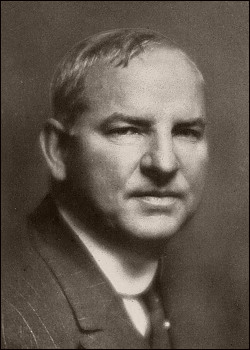
Albert Russel Erskine, 1871 - 1933.
The new corporation was organized basically as before. J. M. was President and Chairman of the Board and Fred Fish was First Vice President. Joining them from Underwood, the typewriter manufacturer, was Albert Russel Erskine, the new Treasurer. With military efficiency Fish and his associates set about repairing damage and building a corporation. The EMF ‘20’ that had caused so many problems was pulled off the market to correct design problems. In fact all production was halted in order to permit redesign. Electric vehicles were dropped completely and Garford was sold to Willys-Overland. J. M. then sanctioned a maneuver that turned into a public relations coup. Mechanics were sent out to every EMF ‘20’ owner and the bad transmissions and other parts replaced. Accompanied by a great deal of advertising, the good will generated by this service undoubtedly exceeded the $1,000,000 cost. When the 1911 models resumed sale, there were more surprises. They now carried no other name than Studebaker. More importantly, prices were cut and generous warranties were included. And it was all announced in a national ad campaign. The public was delighted and the competition nervous. When 1911 drew to a close 22,555 cars had been sold grossing over $28,480,000. Things had never been better but significant change was on the horizon.
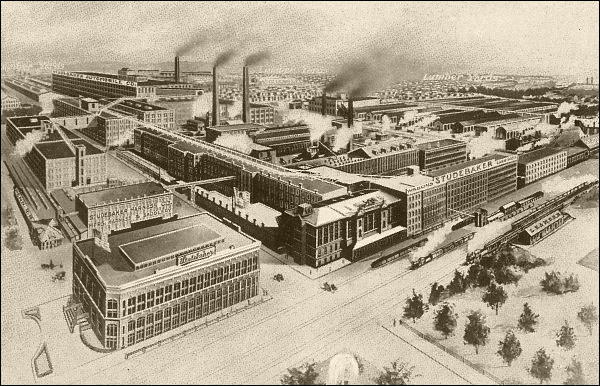
The Studebaker factory in 1910, when the company reorganized to become Studebaker Corporation. ( enlarge )
The power base at Studebaker was beginning to shift. Key positions were being filled from outside the family even though sons and sons-in-law continued to occupy some executive posts. A. R. Erskine, who had joined the firm in 1911, distinguished himself through his organizational skills, and rose to First Vice President by 1913.
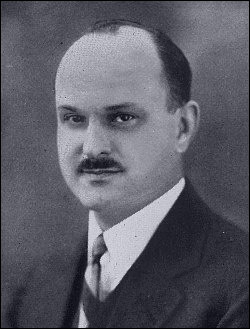
Harold S. Vance.
Harold S. Vance came to South Bend from EMF, Detroit (at Erskines urging) to serve as Assistant Treasurer, thus beginning his ascent. In 1915, the inevitable came to pass as J. M. stepped aside assuming the title of ‘Honorary President’. In July of 1915, Erskine stepped up as President and Fish became Chairman of the Board. J. M. kept his office and continued to concern himself with company affairs until 1917 when he passed his key on to Fred Fish. Eager to enjoy his golden years, John Mohler allowed the next generation take the helm.
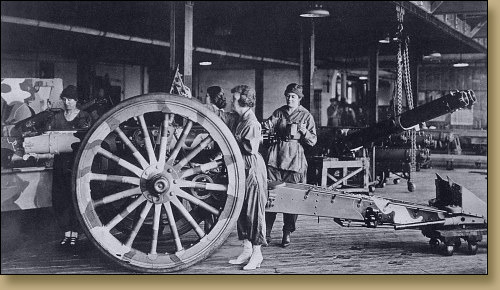
Workers add camouflage to 4.7 inch gun carriages during WW I.
In 1914, Europe was at war and urgent orders for war materials began to pour into South Bend. Although the United States would not enter the ‘Great War’ until 1917, Studebaker became involved when the fateful shot still echoed in Sarajevo. Late in 1914, the British Government placed an order for 3,000 horse drawn wagons (the horse still being an integral component of land warfare). Later they added an order for 20,000 sets of six horse artillery harnesses and 60,000 artillery saddles to be delivered in 20 weeks. Studebaker shipped the completed order in 16 weeks in what is thought to have been the largest munitions order ever placed with a single supplier up to that time. Orders continued coming in from England as well as France and Russia. As the war stalemated in the trenches, the types of equipment sought changed. Equipage for horse mounted troops and horse drawn artillery was replaced by requests for water wagons, ambulances, artillery carriages, bayonet scabbards, staff cars and, late in the war, caterpillars. In 1917, when America finally weighed in, Erskine sent a telegram to the White House placing Studebaker at the Presidents disposal, the first auto maker to do so. As in previous wars, Studebaker selflessly supported it’s government, and as before made little in the process. Erskine wisely looked ahead and was making postwar preparations even as Doughboys were departing for France. He not only had designers working on new cars, but had architects planning new factory facilities.
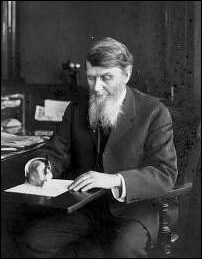
J. M. in his later years.
As the nation embarked on the ‘World War’, another era of Studebaker came to a quiet and dignified close. On March 16, 1917 John Mohler Studebaker passed away at his home. He and his brothers had built an industrial giant from nothing and after his passing, capable and dedicated people would take the business to even greater heights.

1900 - 1918
1900 ushered in a world unimaginable just a few years earlier. Marconi, Edison, Bell and others were pioneering new developments that affected the lives of nearly everybody. One innovation just beginning to make an impact was the horseless carriage. Regarded as an expensive novelty by most, there were some people who saw in it the beginning of a new era in transportation. The new body of executives at Studebaker were among the automotive optimists. Leading them was J. M.’s son-in-law Frederick S. Fish who, upon the death of Peter in 1897, assumed the position of chairman of the executive committee. The second generation of Studebakers were also, for the most part, automobile supporters. The elder Studebakers however, were less enthusiastic. Clem vehemently opposed venturing into automobiles while J. M. was lukewarm on the matter. As the Studebakers debated the issue, Fred Fish was tactfully maneuvering the company into a position favorable to entering the horseless carriage market. Clem, as it turned out, would not live to see the day that Studebaker made automobiles. Upon returning from London during the winter of 1901, he collapsed while debarking the ship and died a few weeks later at his home. With Clems passing, opposition to automobiles finally eroded.
In the late 1890s, steam, gasoline and electricity were all being considered as sources of propulsion by automobile designers. Studebaker had experimented with horseless carriages as early as 1896, but was proceeding cautiously. That year, an electrical engineer named George Strong was retained to work on a battery powered carriage. Studebaker opted to go with electricity early on, largely because they were already making electric carriage bodies for taxis under contract for The New York Electric Vehicle Co. This also eased J. M.'s concerns as he regarded steam and gasoline as noisy and dangerous. The testing came to fruition in 1902 when Studebaker introduced it's first production automobile, the Electric Runabout. The first sale occurred five days before the company's 50th anniversary when F. W. Blees of Macon, Missouri purchased the first Studebaker automobile. Thomas Edison is thought to have purchased the second one.

Thomas Edison on a Studebaker Electric.
Even as the electric runabouts were first rolling out of the factory, there was a perception that gasoline power was going to win out in the end. Fredrick Fish was particularly anxious to move in this direction. The main obstacle for Studebaker, he realized, was they lacked the machinery required to manufacture engines and other automotive components. Cleverly, he was able to solve the problem with the stroke of a pen. The Garford Motor Company of Cleveland, founded by Arthur Garford

1858 - 1933

The Studebaker-Garfords were a success and combined sales figures for wagons and automobiles increased dramatically over the next three years until reaching $7,800,000 in 1907. The increase was directly attributable to automobile sales and demand was approaching the breaking point. Garford could not supply components fast enough to keep pace with sales. Immediately after the initial agreement, Garford had constructed a new factory


A 1908 Studebaker Garford.
In August of 1908 three gentlemen by the names of Barney Everitt

1872 - 1940
As of October 1, 1909 Everett-Metzger-Flanders Company's subsidiaries consisted of the following:
|
Wayne Automobile Co. of Detroit Northern Motor Car Co of Detroit and Port Huron Deluxe Motor Car Co of Detroit Monroe Manufacturing Co of Pontiac Michigan Western Malleable Steel Co of Detroit Pressed Steel Sanitary Manufacturing Co of Detroit |


The EMF plant in 1910.
They had not yet begun production and Fish was able to affect an arrangement that was mutually beneficial. EMF at that time had no means of marketing their cars and Studebaker offered to sell them through their vast national sales network contracting for 500 units. They were marketed as medium priced cars in two models, the `20' and `30' (referring to horsepower) at $1,000 and $1,250. The Garford line was continued as a luxury model selling for $4,000. In the 16 months following the EMF deal 8,132 cars were sold. Twelve months later, at the end of 1910, sales had nearly doubled to 15,300.

A Studebaker-EMF Model 30.
In the interim though, a behind the scenes battle was being waged between Studebaker and EMF. The model `20' had numerous engineering problems, including faulty transmissions and clutches, which EMF was indifferent to remedy. J. M., who still believed "always give more than you promised", was not at all pleased. More importantly, EMF executives were bickering amongst themselves and then turned on Fred Fish accusing him of manipulating stock prices to affect a buyout. Fish was able to appease the trio by purchasing substantial shares of EMF’s stock but just months later tempers flaired again. This time Fish turned to the courts but EMF stood their ground. The outcome, ironically, was that Studebaker purchased the remaining EMF

Albert Russel Erskine, 1871 - 1933.
The new corporation was organized basically as before. J. M. was President and Chairman of the Board and Fred Fish was First Vice President. Joining them from Underwood, the typewriter manufacturer, was Albert Russel Erskine, the new Treasurer. With military efficiency Fish and his associates set about repairing damage and building a corporation. The EMF ‘20’ that had caused so many problems was pulled off the market to correct design problems. In fact all production was halted in order to permit redesign. Electric vehicles were dropped completely and Garford was sold to Willys-Overland. J. M. then sanctioned a maneuver that turned into a public relations coup. Mechanics were sent out to every EMF ‘20’ owner and the bad transmissions and other parts replaced. Accompanied by a great deal of advertising, the good will generated by this service undoubtedly exceeded the $1,000,000 cost. When the 1911 models resumed sale, there were more surprises. They now carried no other name than Studebaker. More importantly, prices were cut and generous warranties were included. And it was all announced in a national ad campaign. The public was delighted and the competition nervous. When 1911 drew to a close 22,555 cars had been sold grossing over $28,480,000. Things had never been better but significant change was on the horizon.

The Studebaker factory in 1910, when the company reorganized to become Studebaker Corporation. ( enlarge )
The power base at Studebaker was beginning to shift. Key positions were being filled from outside the family even though sons and sons-in-law continued to occupy some executive posts. A. R. Erskine, who had joined the firm in 1911, distinguished himself through his organizational skills, and rose to First Vice President by 1913.

Harold S. Vance.
Harold S. Vance came to South Bend from EMF, Detroit (at Erskines urging) to serve as Assistant Treasurer, thus beginning his ascent. In 1915, the inevitable came to pass as J. M. stepped aside assuming the title of ‘Honorary President’. In July of 1915, Erskine stepped up as President and Fish became Chairman of the Board. J. M. kept his office and continued to concern himself with company affairs until 1917 when he passed his key on to Fred Fish. Eager to enjoy his golden years, John Mohler allowed the next generation take the helm.

Workers add camouflage to 4.7 inch gun carriages during WW I.
In 1914, Europe was at war and urgent orders for war materials began to pour into South Bend. Although the United States would not enter the ‘Great War’ until 1917, Studebaker became involved when the fateful shot still echoed in Sarajevo. Late in 1914, the British Government placed an order for 3,000 horse drawn wagons (the horse still being an integral component of land warfare). Later they added an order for 20,000 sets of six horse artillery harnesses and 60,000 artillery saddles to be delivered in 20 weeks. Studebaker shipped the completed order in 16 weeks in what is thought to have been the largest munitions order ever placed with a single supplier up to that time. Orders continued coming in from England as well as France and Russia. As the war stalemated in the trenches, the types of equipment sought changed. Equipage for horse mounted troops and horse drawn artillery was replaced by requests for water wagons, ambulances, artillery carriages, bayonet scabbards, staff cars and, late in the war, caterpillars. In 1917, when America finally weighed in, Erskine sent a telegram to the White House placing Studebaker at the Presidents disposal, the first auto maker to do so. As in previous wars, Studebaker selflessly supported it’s government, and as before made little in the process. Erskine wisely looked ahead and was making postwar preparations even as Doughboys were departing for France. He not only had designers working on new cars, but had architects planning new factory facilities.

J. M. in his later years.
As the nation embarked on the ‘World War’, another era of Studebaker came to a quiet and dignified close. On March 16, 1917 John Mohler Studebaker passed away at his home. He and his brothers had built an industrial giant from nothing and after his passing, capable and dedicated people would take the business to even greater heights.
| More Illustrations |